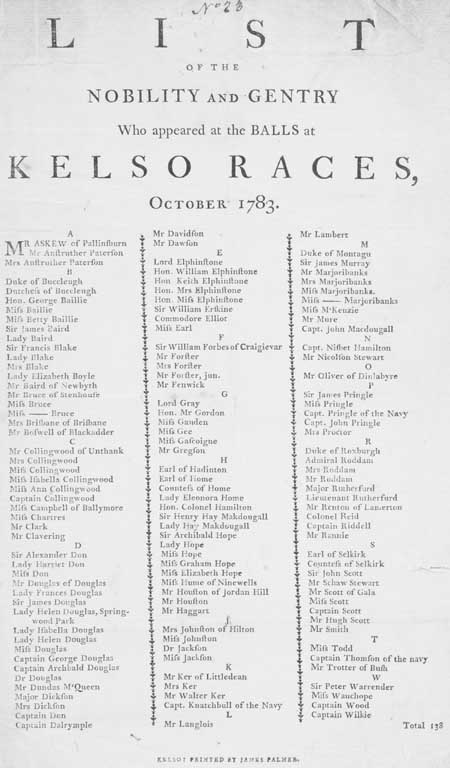Commentary
This broadside begins: 'LIST OF THE NOBILITY AND GENTRY Who appeared at the BALLS at KELSO RACES, OCTOBER 1783.' What then follows is an alphabetical listing of all those who were in attendance. It was published by James Palmer of Kelso. It is noteworthy that this sheet was published in Kelso, since many of the broadsides in the National Library of Scotland's collection were produced in the larger urban centres such as Edinburgh, Glasgow, Aberdeen and Dundee. James Palmer worked out of Kelso as a printer throughout the 1780s and 1790s, and produced a large number of broadsides - many of which dealt with local themes. This broadside could be considered a precursor to the society pages found in some modern-day newspapers and magazines. There was a great deal of interest, as there is today, in the comings and goings within the elite social circles of the upper classes.
Horse races had been held in the Kelso area since the early 18th century. The Duke of Roxburghe supported the meeting and was responsible for the laying out of a new and genuinely flat course (the present one) on the edge of the town at Berrymoss. Unlike other race meetings such as those at Leith and Paisley, Kelso races did not attract massive crowds, being generally confined to the landed classes.
Broadsides are single sheets of paper, printed on one side, to be read unfolded. They carried public information such as proclamations as well as ballads and news of the day. Cheaply available, they were sold on the streets by pedlars and chapmen. Broadsides offer a valuable insight into many aspects of the society they were published in, and the National Library of Scotland holds over 250,000 of them.
View Transcription | Download PDF Facsimile
|
 |
Date of publication:
1783 shelfmark: L.C.Fol.74(325)
 View larger image
View larger image
|


